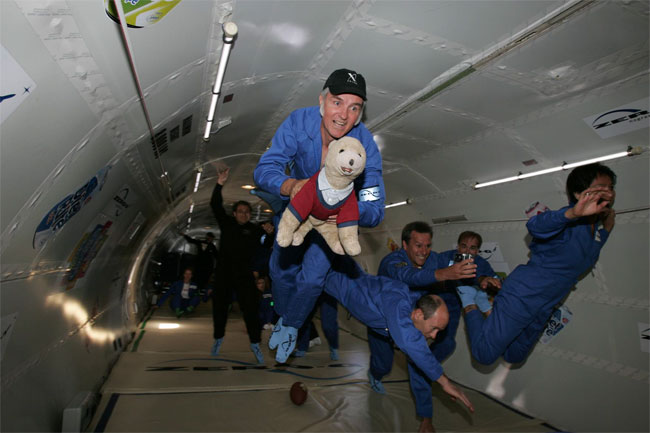Burt Rutan on Civilian Spaceflight, Breakthroughs, and Inside SpaceShipTwo

MOJAVE, CALIFORNIA - As you stroll through the desert airport/spaceport here, you don't see a "Keep Out! Spaceliner Under Construction" sign. On the other hand, there's a palpable feeling that behind closed hangar doors, the future of public space travel is, indeed, a work in progress--and in good hands.
At ScaledComposites--home of the privately financed and built SpaceShipOne that made atrio of piloted suborbital flights in 2004 under the rubric of Tier 1--thefabrication of a fleet of passenger-carrying space planes and huge carrierlaunch planes is underway. This activity is labeled Tier 1b.
Burt Rutan,head of the firm, is chief design maestro leading a spaceliner workforce. Whilehe's not about to roll out blueprints or show you factory floor hardware, hegave this reporter a squat down, legs folded, but relaxing beanbag chairinterview in his office to discuss the business of public space travel.
Wanted:breakthroughs
"First ofall, just because people have kind of discovered 'Oh, now we can have apersonal commercial spaceflight industry' ... that doesn't mean we can just throwmoney at the problem and send people to resort hotels in orbit," Rutan toldSPACE.com.
Rutan admittedthat he's frustrated but committed to building suborbital spaceships.
"I'd loveto be working on going to the Moon. I'm doing this really because I don't thinkI can convince a funder to go out and invest in an orbital system that we'renot sure would work."
Breaking space news, the latest updates on rocket launches, skywatching events and more!
In Rutan'splotting of things to come, Tier 2 is orbital.
"My bottomline is that we have to have some kind of breakthroughs," Rutan explained."What's needed is to create an environment to have breakthroughs ... to trythings that may seem illogical at first."
Long-shot
Lookingback on SpaceShipOne, Rutan said the focus was on safety, on recurring cost,and asking the question: "When we're done with this, if it worked, could itlead right into flying the public? Could it be safe? I don't think that's beendone to go to orbit," he said.
WhileMicrosoft mogul, Paul Allen, bankrolled SpaceShipOne and had a lot ofconfidence in the effort, Rutan added that the investor confessed later that hedid think the suborbital project "was a real long-shot."
"I'mfocusing now on going ahead and doing something that I never did withairplanes. That is, not just do research but go ahead and build something thatwould be certified. Produce it and sell it to spacelines and let them go outthere and compete with each other to fly the public," Rutan said.
His hunchis that by profitably flying people by the tens of thousands, the funding pumpwill be primed, and the recognition fostered that breakthroughs are needed fora high-risk orbital spaceship research program.
"I'mgetting a commercial system going for one reason: I don't think anybody elsewill," Rutan explained. "I think it's really important for me to build a lot ofthem," he added, not just a few for Sir Richard Branson's Virgin Galactic, "but alot of them."
Must havechecklist
In buildingthe multi-passenger SpaceShipTwo, Rutan offered a design glimpse of what's instore for ticket-paying suborbital travelers.
Along withlots of windows, a close second on the "must have" checklist is for customersto experience weightlessness. A person in SpaceShipTwo will feel just fourminutes of freefall, so having a great big cabin is extremely important, Rutanpointed out, "to be able to stretch out your arms and legs and float around."
To gainsome think space about weightlessness, Rutan took his own fact-finding flightaboard the private Zero Gravity Corporation's aircraft.
"Theimpression you get is that it's important to know why you're floating, so youneed windows. You want to fly...you don't want to be strapped in. And toexperience weightlessness in shirtsleeve is important, not being bothered witha pressure suit or tied down to a cable or having a helmet on," he said.
Mega-mothership
GivenSpaceShipTwo's flight path to the edge of space and back, the four minutes offreefall gives you what it would be like to live in orbit for weeks, Rutansuggested. Coming back into the atmosphere, he said, passengers would floatgently to the craft's floor as it takes more than 40 seconds to reachone-gravity.
"That's thereason we feel we'll easily be able to certify people floating around andgetting into a seat...more of a bed to lay flat," Rutan said.
Hauling aSpaceShipTwo into launch position will require use of a mega-mothership that'spatterned after the White Knight aircraft utilized for the Tier 1 program.
That giantairplane will have an identical cabin like that built into SpaceShipTwo. Youcan take up people and float them out of their chairs. "They can't tell theyare not in the spaceship," Rutan said.
Themothership will be an aerobatic airplane, Rutan said, able to provide rehearsalruns that produce seconds of weightlessness for future suborbital spacetravelers, as well as offer a view of the dark blue sky at 50,000 feet (15 kilometers).
"They canpractice floating around, playing games, and to get into their positions forreentry and deceleration. We'll be able to give them the entire reentry gprofile and I think that's extremely important," Rutan noted. "So we've gotsomething here that I think is very special."
Naturalselection
Branson has on order a fleet of spaceliners. But there were other offers before Branson's investment proposal was picked, Rutan confided. "He was selected as an investment source because he was very early telling everybody what he was going to do, and usually I'm against that. But he's putting his reputation onthe goal of this program ... doing that on day one."
Rutan saidthat his biggest concern was investment money "getting chicken" on the courageto take risk and to move forward to tackle issues. "I felt that Branson wasmaking commitments so that he, even without me, had to finish it," he said.
Taking along look out to the next ten to twelve years, Rutan predicted that "there'sgoing to be some very good news and some very bad news."
The badnews, Rutan advised, is related to the government space programs. "I hate tosay that, but the reason is that they are just structured so there will be alot of money spent and they are not likely to reap the benefits that are goingto help us."
The goodnews, Rutan suggested as a guess, is that there will be breakthroughsforthcoming, stemming from what happens after the first generation ofsuborbital craft--including competitors, now known and unknown--take to the sky.
"We needwhat amounts to natural selection to work. Nobody is smart enough to know aheadof time whether something is the right answer. You've got to field the goodones and bad ones for the good ones to float to the top," Rutan said.
- The First Female Space Tourist? U.S. Entrepreneur Determined to Reach Orbit
- Space Tourism: Face Time with Earth
- Space Tourism: A Multimedia Special Report
- New Space: A Multimedia Special Report
- New Mexico Charts Future of Spaceport

Leonard David is an award-winning space journalist who has been reporting on space activities for more than 50 years. Currently writing as Space.com's Space Insider Columnist among his other projects, Leonard has authored numerous books on space exploration, Mars missions and more, with his latest being "Moon Rush: The New Space Race" published in 2019 by National Geographic. He also wrote "Mars: Our Future on the Red Planet" released in 2016 by National Geographic. Leonard has served as a correspondent for SpaceNews, Scientific American and Aerospace America for the AIAA. He has received many awards, including the first Ordway Award for Sustained Excellence in Spaceflight History in 2015 at the AAS Wernher von Braun Memorial Symposium. You can find out Leonard's latest project at his website and on Twitter.
